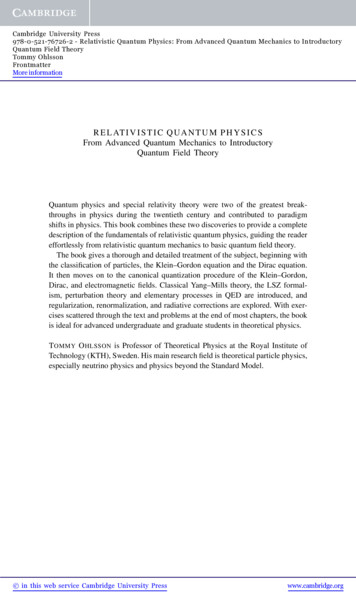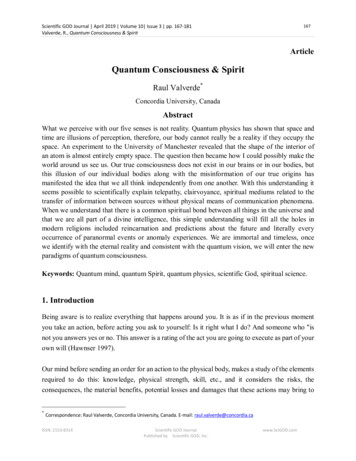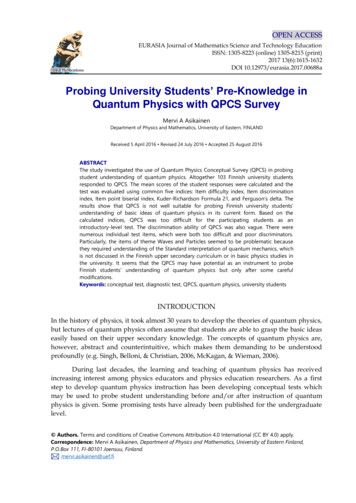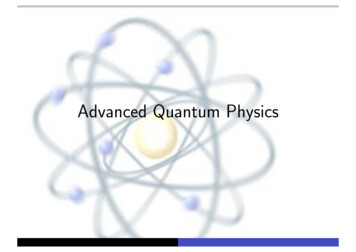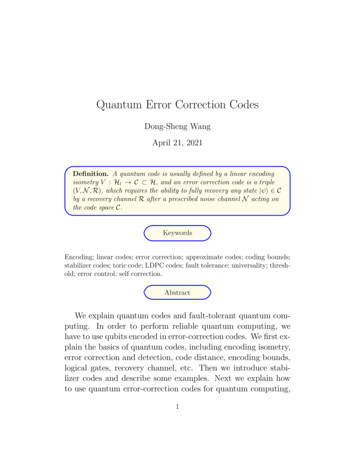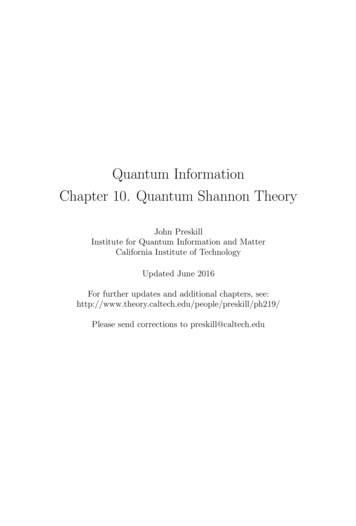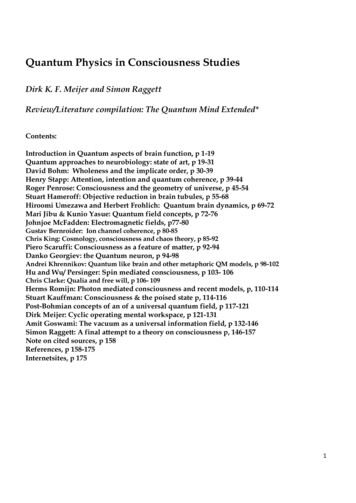
Transcription
Quantum Physics in Consciousness StudiesDirk K. F. Meijer and Simon RaggettReview/Literature compilation: The Quantum Mind Extended*Contents:Introduction in Quantum aspects of brain function, p 1-19Quantum approaches to neurobiology: state of art, p 19-31David Bohm: Wholeness and the implicate order, p 30-39Henry Stapp: Attention, intention and quantum coherence, p 39-44Roger Penrose: Consciousness and the geometry of universe, p 45-54Stuart Hameroff: Objective reduction in brain tubules, p 55-68Hiroomi Umezawa and Herbert Frohlich: Quantum brain dynamics, p 69-72Mari Jibu & Kunio Yasue: Quantum field concepts, p 72-76Johnjoe McFadden: Electromagnetic fields, p77-80Gustav Bernroider: Ion channel coherence, p 80-85Chris King: Cosmology, consciousness and chaos theory, p 85-92Piero Scaruffi: Consciousness as a feature of matter, p 92-94Danko Georgiev: the Quantum neuron, p 94-98Andrei Khrennikov: Quantum like brain and other metaphoric QM models, p 98-102Hu and Wu/ Persinger: Spin mediated consciousness, p 103- 106Chris Clarke: Qualia and free will, p 106- 109Herms Romijn: Photon mediated consciousness and recent models, p, 110-114Stuart Kauffman: Consciousness & the poised state p, 114-116Post-Bohmian concepts of an of a universal quantum field, p 117-121Dirk Meijer: Cyclic operating mental workspace, p 121-131Amit Goswami: The vacuum as a universal information field, p 132-146Simon Raggett: A final attempt to a theory on consciousness p, 146-157Note on cited sources, p 158References, p 158-175Internetsites, p 1751
Introduction in quantum aspects of brain functionSince the development of QM and relativistic theories in the first part of the 20 th century,attempts have been made to understand and describe the mind or mental states on the basis ofQM concepts (see Meijer, 2014, Meijer and Korf, 2013,). Quantum physics, currently seen as afurther refinement in the description of nature, does not only describe elementarymicrophysics but applies to classical or macro-physical (Newtonian) phenomena as well.Hence the human brain and its mental aspects are associated to classical brain physiology andare also part of a quantum physical universe. Most neurobiologists considered QM mindtheories irrelevant to understand brain/mind processes (e.g. Edelman and Tononi, 2000;Koch and Hepp, 2006).However, there is no single theory on QM brain/mind theory. In fact a spectrum of more orless independent models have been proposed, that all have their intrinsic potentials andproblems. The elements of quantum physics discussed here are summarized in Table 1 and 2;details of the various QM theories have been described elsewhere (Meijer, 2012; Meijer andKorf, 2013).Some QM mind options assume some sort of space-time multidimensionality, i.e there aremore than the four conventional space-time dimensions. Other options assume that one ormore extra dimensions are associated with a mental attribute or that the individual mind is(partly) an expression of a universal mind through holonomic communication with quantumfields (Fig.1). The latter idea has led to holographic (holonomic) theories (Pribram 1986, 2011).The human brain is then conceived as an interfacing organ that not only produces mind andconsciousness but also receives information. The brain or parts of the brain are conceived as aninterference hologram of incoming data and already existing data (a “personal universe”). Ifproperly exposed (“analyzed”), information about the outer world can be distilled.In neurobiological terms, the existing data is equivalent to the subject’s memory, whereas the“analyzer” is cerebral electrophysiology. Bohm hypothesized that additional dimensions arenecessary to describe QM interference processes, thereby circumventing probabilistic theoriesand consciousness-induced collapse of the wave function. In this theory, the universe is a giantsuperposition of waves, representing an unbroken wholeness, of which the human brain is apart (Bohm, 1990). Accordingly, the individual mind or consciousness is an inherent propertyof all matter (and energy), and as such being part, or rather an expression, of this universalquantum field. The apparently diffuse time/space localization of mental functions argues infavor of an underlying multidimensional space/time reality. Bohm and Hiley (1987) alsoproposed a two-arrow (bidirectional) time dimension. In this concept the stochastic (or doublestochastic) character of quanta is explained by an underlying quantum field: the implicate order.This concept implies entanglement (non-locality) as well.2
Another hypothesis, having the potential to couple wave information to mental processes,proposes that wave information is transmitted from and into the brain by wave resonance.Through conscious observation they collapse locally to material entities (Stapp 2009; Pessaand Vitiello, 2003; Schwartz et al., 2004). Stapp (2012) argued that this does not represent aninterference effect between superposed states (as assumed by Hameroff and Penrose, 1996), butthat through environmental de-coherence, super-positions become informative to thebrain/organism. A complementary implication of these theories is that mental processes arenot necessarily embedded in entropic physical time. In line with this QM idea is that memoriesare not stored as a temporal sequence, but rather a-temporally.Fig. 1: The hypothesis that the universe and our minds are integral parts of a universalconsciousnessSome QM mind theories suppose the possible involvement of specific molecules. A spectrumof ions and molecules has been suggested to operate in a quantum manner (Tuszinsky andWoolf 2010). For instance QM theories have been based on micro-tubular proteins (Penrose1989; Hameroff 2007), proteins involved in synaptic transmission (Beck and Eccles 1992; Beck2001), including Ca ion-channels (Stapp 2009) and channel proteins instrumental in theinitiation and propagation of action potentials (potassium-ion channels, Bernroider and Roy2004. There is also the hypothesis that synaptic transmission represents a typical (quantum)probability state that becomes critical for an all or none neuronal response (Beck and Eccles1992; Beck 2001). Attributing non-linear and non-computable characteristics of consciousness,3
Hameroff and Penrose, 2011, 2013, argue against mechanisms of all or none firing of axonalpotentials (Beck and Eccles, 2003). They rather prefer the model of Davia (2010), proposingthat consciousness is related to waves traveling in the brain as a uniting life principle onmultiple scales. According to some QM mind theories (Woolf and Hameroff, 2001), tunnelingwas proposed to facilitate membrane/vesicle fusion in neural information processing at thesynapse.Kauffman relates quantum processes in the biological matrix of the brain to the emergence ofmental processing (Kauffman 2010; Vattay et al. 2012). This theory, mainly based onchromophores detecting photons, assumes that the coherence of some quantum configurationsadhered to proteins is stabilized or is maintained by re-coherence. This principle may haveguided evolutionary selection of proteins. Accordingly, mind and consciousness are bothquantum mechanical and an expression by the classical neural mechanisms. The underlyingcoherent quantum states provide the potentiality for the collapse to the de-coherent materialstate, resulting in classical events such as firing neurons, that are at least to some extent, acausal, i.e. beyond classical determinacy. The quantum system (of the brain) interacts with aquantum environment, the phase information is lost and cannot be reassembled. Byentanglement, the quantum coherence in a small region, e.g. the cell or the brain, might havespatial long-range effects (Vattay et al. 2012; Hagan et al. 2002). Kauffman accepts long-livedcoherence states in biological molecules at body temperature (now 750 femto-seconds inchlorophyll at 77K) to be potentially enabling parallel problem solving as major challenges forfurther investigations. The question is also which neurons or neuronal structures are inparticular associated to the coherence/de-coherence brain model of consciousness.The question is often put as to why quantum theory should be involved in discussions ofconsciousness at all, and also as to why it should be treated as something special. In thinkingabout quantum theory, it is important not to be bullied into viewing it as something weird andperipheral that can be ignored (Atmanspacher, 2011). Unfortunately, this allows the moresuperficial thinkers to dismiss all theories of quantum consciousness. This sort of practice hasrecently been criticized as ‘pseudoscepticism’, a parallel form to pseudoscience. Pseudoskepticism (see Wikipedia) similarly uses denunciation in the name of science or scientificaffiliation without citing any evidence or possible experimentation to establish this criticism,(see Utts and Josephson, 1996). The features of quantum theory that make it special and alsopossibly relevant to consciousness can be summarized as follows:1.) Quantum theory describes the fundamental level of energy and matter. In contrast tohigher levels, the quantum level has aspects, such as mass, charge and spin that are givenproperties of the universe, not capable of further reduction or explanation. In quantumtheories of consciousness, it is suggested that consciousness is such a fundamental propertyexisting at this level. Some theories are additionally linked to the structure of spacetime, which4
is nowadays seen as being interconnected with the nature of the quanta( see Chalmers, 2000;Nagel, 2012)2.) The other fundamental aspect of the universe is spacetime, as described by the special andgeneral theories of relativity. Although both relativity and quantum theory have both beentested to very high degrees of accuracy, they are nevertheless incompatible with one another.The gravitational force is the main problems, since the smooth continuous curvature of spacethat describes gravity in general relativity is incompatible with the discreteness ofparticles/waves that is fundamental to quantum theory. String theory and loop quantumgravity have attempted to bridge this gap, but neither are yet regarded as giving a completepicture. (see Smolin, 2004; Penrose, 2004)3.) In traditional versions of quantum theory, the wave form of the quanta is conceived as asuperposition of the many possible positions of a quantum particle. When the wave functioncollapses the choice of a particular position for the particle is random. This choice of position isan effect without a cause. The property of randomness is not in itself particularly useful intheories of consciousness, but it does open a chink in the deterministic structure of theuniverse, which is exploited in particular by the Penrose/Hameroff model, 2013, see alsoStapp, 2009, 2012)4.) Non-locality is the remaining special feature of quantum theory. Classical physicscomprises only so-called billiard ball relationships, with bits of matter and energy bumpinginto one another. These relationships are local, in that they involve immediate contact. Suchrelationships are also normal in quantum physics. However, quantum physics also possessesnon-local relationships. This applies where two particles have been in some close relationship,such as two electrons in the same orbital. In this case they can become correlated. For instancethe spin on two particles may always be opposite, if one spins up, the other spins down. Thisis not a problem while the particles are in a wave form, as both will be in a superposition of upand down. However, if the wave function of one particles collapses, that particle chooses oneor the other superposition. When that happens, the other particle will choose the oppositeposition. In experiment, this is shown to happen when the two particles are out of range of asignal travelling at the speed of light. No matter, energy or conventional information istransferred, and the experiment is not regarded as a violation of relativity, but it isdemonstrated that quantum properties can correlate instantaneously over any distance.(see fora basic introduction to QM: Thomas A, link internet.The Failure of Modern Consciousness StudiesThe study of consciousness was a taboo in academic circles through much of the 20th century,at least in part due to the long reign of behaviorism. Even the study of emotion being largelyproscribed, with brains conceived as being reasoning machines and nothing else. This started5
to lift in the late 1980s and at first this seemed to be a marvelous opportunity for the advancesmade in other areas of science to be applied to the neglected area of consciousness. Whatfollowed, however, can be seen as an overall negative in establishing orthodoxies whichappear to have negligible chance of success in explaining consciousness, while discouragingexplanations that relate to new areas of physics or neuroscience.The traditional explanation for consciousness or the soul in more traditional language isknown as dualism. This posits a separate spirit stuff and physical stuff, with the spirit stuffcapable of acting on the physical stuff, as when the soul commands the body. The coreargument against dualism was that for the spirit stuff to act on the physicsal stuff it wouldneed to have some physically relevant quality and would therefore not be pure spirit stuff. Vice versa looks to apply for physical stuff. The failure of dualism is one of the few points ofagreement between mainstream consciousness studies and those that identify consciousnesswith a fundamental of the universe. (Thompson, 2000)Functionalism was at least in the 1990s the dominant explanation for consciousness, driven bythe success of computers as problem solving and memory storage machines. The mainproposal is that any system or machine that processes information in the same way as thebrain will be conscious, regardless of what it is made of. The biological matter and structure ofthe human brain was deemed irrelevant. In reality, and despite its popularity, this appears as apseudo-theory, kicking the problem of consciousness further down the road. It does notexplain how consciousness arises in the brain and nor does it explain how consciousnessmight at some point arise in silicon or other matter. It seems, however, that functionalism hashad a malign effect in making mainstream consciousness studies practitioners think it unnecessary to take any notice of modern developments in neuroscience or biology.Identity theory may have been the next most popular theory after functionalism in the 1990s.This declared that consciousness was identical to the brain or identical to its processing.However, it made little attempt to explain why it was identical to the brain, but not to any ofthe other physical structures in the universe. Nor did it attempt to define what it meant by thebrain, despite the fact that our understanding of the physical processing of the brain waschanging dramatically. It was further undermined by the discovery that much neuralprocessing such as the dorsal stream governing spontaneous movement could be brought tocompletion outside of consciousness, which was seen to be more closely related to longer-termevaluations and planning.Epiphenomenalism was and remains another popular idea. The theory proposes thatconsciousness is a by-product of neural processing that has, however, no function. Despite itspopularity this concept is beset by at least three major problems. It conflicts with evolutionarytheory in that it is hard to see why evolution should select for something that had no function,6
particularly as neural processing is exceptionally energy-hungry. The theory also conflictshead on with physics in which there is no acausality, with every object or process havinginfluences elsewhere. Finally, there is the problem that even granting the idea of a functionlessby-product, there is still no physical evidence for what produces such a thing in the brain. Likefunctionalism it appears to be a pseudo-theory.In the present century, there seems to have been a tacit recognition that functionalism andidentity theory would have difficulty in becoming the consensus of a wider public. Thisappears to have given rise to two more theories that avoid treating consciousness as afundamental. Consciousness resulting from embodiment has been possibly the mostfashionable of these ideas. Initially embodiment ideas did represent a genuine step forward inboth consciousness studies and psychology as a move away from the brain as a computer in avat. It now accepted that mental events could influence the body and that visceral eventscould feed back on the brain. It also accepted that emotion is a relevant aspect of mental life.However, there was an over-reach in suggesting that the body somehow drove consciousnessthat the brain could not produce. This seemed to assume some kind of undefined specialproperty in the body that was not present in the brain. More specifically it ignored the factapart from the sense of touch, signals entered the brain directly from the environment andwere consciously processed in the higher sensory and frontal cortex before being signaled tothe viscera.The attempt to classify consciousness as a form of information or information processing hasalso become fashionable in this century. Interestingly, there are innumerable examples of nonconscious information, especially when we look at modern technology, with no apparentspecification as to how conscious information would differ from non-conscious information.(Meijer, 2012, 2013a, 2014)At a more philosophical level, there is a core difference between information and reality, inthat information embraces only what we happen to know, while it can also be defined as anattempt to describe nature’s behavior and microscopic make up that comprises reality. Thusthe hunter-gatherer in ancient Africa, glancing up at the sun is only aware of its glare, heat andposition in the sky. A fuller understanding of its reality has to wait for modern science.A popular but poorly based concept is to call consciousness an emergent property: The ideaof consciousness as an emergent property of classically described matter is superficiallyplausible, and as such can sometimes look like the best shot of modern consciousness studies.Emergence is a familiar process in physics. Thus liquidity is an emergent property of water.The individual component hydrogen and oxygen atoms do not have the property of liquidity.However, when they are bound together in a sufficiently large number of water molecules, theproperty of liquidity emerges.7
The problem for this as an explanation of consciousness is that when emergent properties suchas liquidity arise in nature, the emergence can be traced to the component particles and forces,such as the electromagnetic interactions between the water molecules. The macroscopicliquidity is an effect of the microscopic electrical charges and the resulting chargerelationships. The problem for consciousness as an emergent property is no arrangement ofsuch particles and forces has been identified that could produce consciousness. Many continueto furiously assert that this is possible, but the claim being made here is in fact the same asdualism, where two things that have no common property are required to act on one another.Anybody who thinks this is possible in physics could simplify their search for consciousnessby accepting the idea of dualistic spirits (Murphy, 2007, 2011, Auletta et al, Clayton andDavies, 2006 ).In the last two decades, consciousness studies has gone off in a different direction fromphysics or neuroscience. Much of consciousness studies is dominated by philosophers andpsychologists who have only a scant interest in what has been happening in brain science, letalone physics. In many cases, they see it as their duty up to prop a nineteenth centuryNewtonian world view, while dealing in abstractions that that take limited account ofneuroscience or physics. Neuroscientists have meanwhile been pressured into treatingconsciousness as not part of their remit, deferring to philosophers when it was necessary todiscuss consciousness, even when the philosophy was contradicted by the neuroscientists owndiscoveries. More fundamental approaches have fallen victim to black propaganda againstthem. It seems likely that mainstream consciousness studies, if it survives at all, will reach theend of the 21st century without having achieved consensus on a theory that has explanatoryvalue.The Descent into the Quantum WorldSuppose one were to ask for a scientific description of your hand. Biology could describe it interms of skin, bone, muscles, nerves, blood etc., and this might seem a completely satisfactorydescription. However, if you were just a bit more curious, you might ask what the muscle andblood etc. were made of. Here you would descend to a chemical explanation in terms ofmolecules of protein, water etc. and the reactions and relations between these. If you were stillnot satisfied with this, you would have to descend into the quantum world. At this level, thesolidity and continuity of matter dissolves. The molecules of protein etc. are made up ofatoms, but the atoms themselves are mainly vacuum. Most of the mass of the atom lies in asmall nucleus, comprised of protons and neutrons, which are themselves made up of smallerparticles known as quarks. The rest of the mass of the atom resides in a cloud of electronsorbiting around the nucleus (see Fig.2).8
Fig.2 : Some central elements of quantum physics: uncertainty of position of particles, wave / particleduality as demonstrated in the double-slit experiment (upper part),as well as entanglement (nonlocality) of particles at great distances, the phenomenon of coherence/decoherence and superposition ofwaves (lower part).The fundamental particles are bound together by the four forces of nature, which are gravity,electromagnetism and the strong and the weak nuclear forces. The strong nuclear force bindstogether the particles in the nucleus of the atom, and acts only over the very short range of thenucleus itself. Gravity is a long-range force that mediates the mutual attraction of all objectspossessing mass. The electromagnetic force is perhaps the force most apparent in everydaylife. We are familiar with it in the form of light, microwaves and X-rays. It holds together theatom through the attraction of the opposite electrical charges of the electron and the proton. Italso governs the interactions between molecules. Van der Waals forces, a weak form of theelectromagnetic force is vital to the conformation of protein and thus to the process of lifeitself. In contrast to the nuclear forces, gravity and electromagnetism are conceived of asextending over infinite distance, but with their strength diminishing according to the inversesquare law. That is, if you double your distance from an object, its gravitational attraction willbe four times as weak. The quanta can be divided into two main classes, the fermions, whichpossess mass and the bosons which convey energy or the forces of nature. The mostfundamental fermions are the quarks making up the nucleus and the circling electrons, whilegluons and photons are the most prominent bosons. The gravitons, which may intermediatethe gravitational force remain hypothetical.9
The Quantum WaveThe quantum particles or quanta are unlike any particles or objects that are encountered in thelarge scale world. When isolated from their environment they are conceived as having theproperty of waves, but when they are brought into contact with the environment, there is aprocess of decoherence, in which the wave function is described as collapsing into a particle.The wave form of the quanta is different from waves in matter in the large scale world, such asthe familiar waves in the sea. These involve energy passing through matter. By contrast, thequantum wave can be viewed as a wave of the probability for finding a particle in a specificposition. This probability wave also applies to states of the quanta such as momentum. Whilethe quanta remains in its wave form, it is viewed as a superposition of all the possiblepositions that the particle could occupy. At the peak of the wave, where the amplitude isgreatest, there is the highest probability of finding a particle, when the wave eventuallycollapses. However, the choice of position for each individual particle is completely random,representing an effect without a cause. This comprises the first serious conceptual problem inquantum theory.The Two-Slit Experiment in Quantum MechanicsThe physicist Richard Feynman said that this classic experiment contained all the problems ofquantum theory. In the early nineteenth century, an experiment by Thomas Young showedthat when a light source shone through two slits in a screen, and then onto a further screen,then a pattern of light and dark bands appeared on a further screen, indicating that the lightwas in some places intensified and in other reduced or eliminated. Where two waves ofordinary matter, for instances waves in water, come into contact an interference pattern forms,by which the waves are either doubled in size or cancelled out. This appearance of thisphenomenon in Young’s experiment demonstrated that light was a wave, contrary to mostscientific opinion prior to the experiment.Later, the experiment was refined. It could now be performed with one or two slits open. Ifthere was only one slit open, the photons or light quanta, or any other quanta used in theexperiment behaved like particles. They passed through the one open slit, interacted with thescreen beyond and left an accumulation of marks on that screen, signifying a shower ofparticles rather than a wave. But once the second slit was opened, the traditional interferencepattern, indicating interaction between two waves, reappeared on the screen. The ability togenerate the behavior of either particles or waves, simply according to how the experimentwas set up, showed that the quanta had a perplexing wave/particle duality.10
Fig. 3: The famous double slit experiment: single particles behave like a wave front that showinterference pattern on the screen (a), even after passing the two slits decisions to open or close a slitinfluences the final pattern (b).The wave/particle duality was shocking enough, but there was worse to come. Technologyadvanced to the point where photons could be emitted one at a time, and therefore impactedthe screen one at a time (Fig. 3). What is remarkable is that with two slits open, but thephotons impacting one at a time, the pattern on the screen formed itself into the light and darkbands of an interference pattern. Somehow the photons ‘knew’ to arrange themselves into apattern indicative on the interaction of waves. The question arose as to how the photonsemitted later in time ‘knew’ how to arrange themselves relative to the earlier photons in such away that there was a pattern of light and dark bands, indicative of interacting waves.The obvious solution was to place photon counters at the two slits in order to monitor whatthe photons were up to. However, as soon as a photon is registered by a counter, it collapsesfrom being a wave into being a particle, and the wave related interference pattern is lost fromthe further screen. The most plausible way to look at it may be to say that the wave of thephoton passes through both slits, or possibly that it tries out both routes, and after doing thisthe divided wave interferes with itself ( see Fig. 3).The EPR Experiment and the Copenhagen InterpretationEinstein disliked the inherent randomness involved in the collapse of the wave function. Thiswas despite the fact that his revival of the idea of light in the form of discrete particles orquanta had contributed to the foundation of quantum theory. He sought repeatedly to showthat quantum theory was flawed, and in 1935 he seemed to have produced a masterstroke in11
the form of the EPR (Einstein, Podolsky, Rosen) experiment. At the time this was only a‘thought experiement’, a mental simulation of how a real experiment might proceed, but since1982 it has been possible to perform this as a real experiment (Fig.4).Fig.4: Quantum entanglement in a pair of distant elementary particles with regard to spinThe challenge to quantum theory presented by the EPR experiment hinges on the concepts oflocality and non-locality. Locality comprises the idea of normal cause and effect under whichobjects or particles move or change as a result of being impacted by other objects or particles,or of being directly acted on by energetic forces such as the electromagnetic force. It is localbecause the object or force producing the action or change has to be in direct contact with theobject or particle acted on. Moreover, where a force emitted by one object acts on anotherdistant object such as light emitted from the Sun acting on the Earth, the force passes betweenthe two objects at a speed not greater than that of light. By contrast, non-locality involves theability of one particle to determine the behaviour of another distant particle instantaneously,and without any matter or energy passing between the two. Einstein termed this ‘spookyaction at a distance’.With the EPR experiment it was shown, that as it stood, quantum theory violated the principleof locality, which is normally regarded as basic to scientific thinking and even to commonsense. Quantum theory indicated that when two quanta had been closely related to oneanother, for instance in the same electron orbital, they could be regarded as quantumentangled. In this state, certain aspects of their behavior in relation to one another became12
fixed. For instance, quantum particles have a property of spin, which is partly analogous to thespinning of large-scale objects. Quanta can have the property of spin-up
Dirk K. F. Meijer and Simon Raggett Review/Literature compilation: The Quantum Mind Extended* Contents: Introduction in Quantum aspects of brain function, p 1-19 Quantum approaches to neurobiology: state of art, p 19-31 David Bohm: Wholeness and the implicate order, p 30-39 Henry Stapp: Attention, intention and quantum coherence, p 39-44
